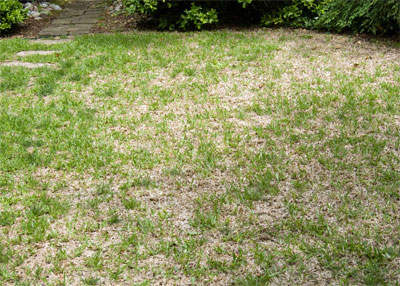St. Augustine Problems

If your St. Augustine has come out of the starting blocks lethargically, you’re far from alone. From its northern boundaries along the Red River, clear into Central Texas, the Gulf Coast and even deep East Texas, St. Augustine lawns are hurting this spring.
Texas A&M Extension Turf Specialist Dr. James McAfee says that he’s had reports from Austin to Houston and even in East Texas of the same problem. He feels much of it is due to winter damage. While this winter was certainly not our coldest in history, it must have caught St. Augustine in a vulnerable condition.
However, Dr. McAfee says that Take All Root Rot is also involved in many of these lawns. This fungal disease attacks the St. Augustine root system, leaving irregular areas dead and lifeless on the ground, almost like damage done by white grub worms. Those patches would have pulled loose easily from the soil, since they had limited roots to anchor them. However, he says it’s late enough that clues for a precise ID of the problem would be difficult to find now.
Dr. McAfee agrees that the 1-inch layer of Canadian sphagnum peat moss is the best means of helping your lawn regain its strength. This research was done several years ago by Dr. Phil Colbaugh, research plant pathologist, now retired. Dr. Colbaugh suggests applying the peat in late April or May, and he has shown dramatic improvement in the health and vigor of treated lawns. Dr. McAfee says that he is aware of home and commercial properties that make such an application annually each spring, although Dr. Colbaugh’s research suggested it could be used every two or three years.
TARR is most prevalent in alkaline soils, and the peat moss serves to acidify the soil’s surface and retard development of the fungus. Curiously, this problem does also occur in the acidic soils of East Texas – it’s just not as widespread and not as serious there.
Your solution at this point:
1. Apply the 1-inch layer of Canadian peat (doesn’t matter which brand). Break it into small chunks as you rake it across the lawn.
2. As the lawn improves, apply an all-nitrogen fertilizer to promote vigorous growth before mid-summer.
3. Keep the grass mowed at 2 to 2.5 inches, and water it whenever it begins to show signs of drought (folded blades and darker green color).
For the record:
Before you give up on St. Augustine entirely, remember that it is by far more tolerant of shade than bermuda. It also is far less invasive, and it’s a lot less likely to cause allergic reactions to mold spores than bermuda turf. As I often tell people, we all have many friends who come with a certain amount of "baggage." We love them just the same, and we learn to cope with their weaknesses.

